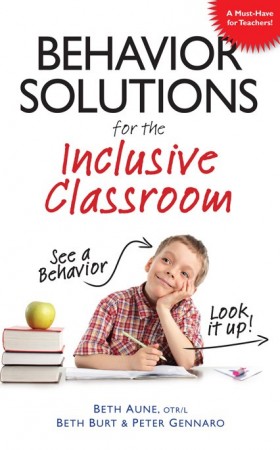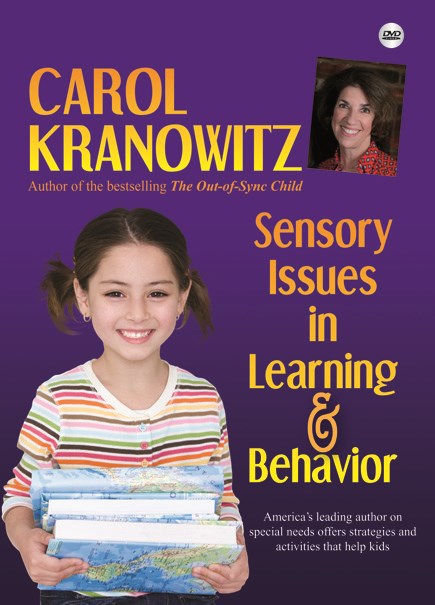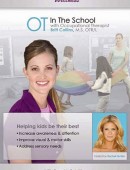Description
WHY won’t he stay in his seat?
WHY does she flap her hands?
And WHAT should I do??
As inclusion becomes the norm in general education, teachers are faced with behaviors they have never seen before. Special needs educators may recognize the telltale symptom of a sensory need or a textbook-case of an avoidance behavior, but this is all new territory for the general-ed crowd!
Written by Director of Special Education Peter Gennaro, occupational therapist Beth Aune, and special needs mom and advocate Beth Burt, this book illuminates possible causes of those mysterious behaviors, and more importantly, provides solutions! Teachers can quickly look up an in-the-moment solution and learn about what the child is communicating, and why.
The authors collaboratively address problem behaviors such as:
- Out-of-Seat Behaviors
- Fidgeting
- Hand-flapping
- Covering Ears
- Hiding or Running Away When Upset
- Putting Head Down or “Shutting Down”
- Difficulty with Class Work and Homework
- Losing Materials and Missing Assignments
- Poor Handwriting
- Not Following Directions
- Saying Rude or Inappropriate Things
- Clothing Issues
- Difficulty Making Decisions
- Excessive Talking
- Laughing Excessively or Being Silly
- Little or No Eye Contact
- Temper Outbursts
- And many others!
Teachers, it is possible to accommodate learning differences and sustain a positive learning environment for ALL students. This book is a must-have for every inclusive classroom!
Binding: Paperback
Pages: 151
Beth Aune, OTR/L currently has a private practice as a pediatric occupational therapist in the Coachella Valley area. She and her dedicated staff provide intervention for children with autism spectrum disorder, developmental disabilities, and other diagnoses in a variety of environments: early intervention in the home, for general and special education students in the school setting, and in the clinical setting. Beth has developed and presented numerous workshops and trainings for parents and educators that focus on the care and treatment of children with disabilities. She is passionate about her profession as an occupational therapist and considers it a calling. She lives in Palm Desert with her three children.Beth Burt currently resides in Southern California with her husband, their two sons, two cats, and a dog. Because of her experience with her own children, one with an autism spectrum disorder (ASD) and the other with a learning disability, she became an advocate. She has over thirteen years of experience collaborating and advocating on the behalf of students with ASD and other disorders. She has been actively involved in numerous task forces and committees related to children, disabilities, and education. She has presented numerous times in Southern California to colleges, conferences, parent groups, and businesses. She is currently President of the Inland Empire Autism Society and is a board member of the Autism Society California and Visions R Us, a nonprofit organization that assists young adults with special needs in making the transition from high school to desired employment.Peter Gennaro is currently the Director of Special Education for the Alvord Unified School District in Southern California. He served as Special Education Coordinator and as Program/Inclusion Specialist prior this. As a teacher, he taught classes for students with emotional disturbances and has taught direct service special education classes consisting of students with varying disabilities. In his current position he continues to work closely with teachers, service providers, and families to develop and implement successful student programs.
Introduction
Section One: Movement Issues
Arm- & Hand-flapping
Arm-swinging
Breaking Pencils and/or Crayons
Bumping Into Other Students/Touching
Inappropriately
Chewing on Shirt or Other Inappropriate Items
Excessive Yawning
Fidgeting
Out-of-Seat Behaviors
Excessive Hugging, Leaning against People, or Pushing People
Taking Off ShoesSection Two: Avoidance and Retreat Behaviors
Avoiding Physical Contact or Messy Activities
Covering Ears
Hiding or Running Away When Upset
Putting Head Down or “Shutting Down”Section Three: Difficulty with Routine and Academics
Difficulty with Carpet Time
Difficulty with Lining Up
Difficulty Starting Assignments
Difficulty with Small Group Activities
Difficulty with Homework
Losing Materials and Missing Assignments
Messy Desk or Disorganized Binder
Poor Handwriting
Not Attending/Off Task or Not Following Directions
Not Following Playground Rules
Problems at Lunchtime
Not Asking for Help
Transitioning and the Insistence on SamenessSection Four: Social-Emotional Issues
Saying Rude or Inappropriate Things
Clothing Issues
Difficulty Accepting Criticism
Difficulty Making Decisions
Excessive Talking
Humming, Talking to Self, or Inappropriate Vocalizations/Odd Gestures
Interrupting
Laughing Excessively or Being Silly
Little or No Eye Contact
Smelling People or Objects
Talking Loudly
Temper Outbursts
Appendix A: Movement Breaks/Goal-Directed Tasks
Appendix B: Sensory Input Devices
Appendix C: Calming Techniques
Additional Resources
About the Authors
Index



